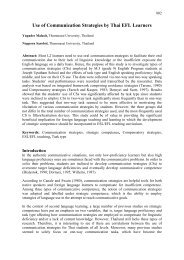The Effects of Semantic Mapping on Vocabulary Memorizing
The Effects of Semantic Mapping on Vocabulary Memorizing
The Effects of Semantic Mapping on Vocabulary Memorizing
Create successful ePaper yourself
Turn your PDF publications into a flip-book with our unique Google optimized e-Paper software.
Feature 3 Items in bedroom (Gairns and Redman, 1986)<br />
4.2. <str<strong>on</strong>g>Semantic</str<strong>on</strong>g> mapping in vocabulary teaching and learning<br />
Sokmen (1997) menti<strong>on</strong>ed four techniques for semantic elaborati<strong>on</strong>: semantic feature analysis,<br />
semantic mapping, ordering, and pictorial schemata. In this secti<strong>on</strong>, semantic mapping in<br />
vocabulary teaching and learning is c<strong>on</strong>cerned about.<br />
Since vocabulary c<strong>on</strong>sists <str<strong>on</strong>g>of</str<strong>on</strong>g> a series <str<strong>on</strong>g>of</str<strong>on</strong>g> interrelating systems and is not just a random collecti<strong>on</strong><br />
<str<strong>on</strong>g>of</str<strong>on</strong>g> items, there seems to be a clear case for presenting items to students in a systematized manner<br />
which will both illustrate the organized nature <str<strong>on</strong>g>of</str<strong>on</strong>g> vocabulary and at the same time enable<br />
students to internalize the items in the coherent way. Words are related to each other in various<br />
ways. Two examples are that (1) the meaning <str<strong>on</strong>g>of</str<strong>on</strong>g> a word depends to some extent <strong>on</strong> its<br />
relati<strong>on</strong>ship to other similar words, <str<strong>on</strong>g>of</str<strong>on</strong>g>ten through sense relati<strong>on</strong>s, and (2) words in a word family<br />
are related to each other through inflecti<strong>on</strong>al and derivati<strong>on</strong>al affixes (Schmitt, 2000). In<br />
semantic mapping, words are grouped in the former way.<br />
<str<strong>on</strong>g>Semantic</str<strong>on</strong>g> mapping has been usually used for (1) general vocabulary development, (2) pre and<br />
post-reading, (3) teaching <str<strong>on</strong>g>of</str<strong>on</strong>g> a study skill, (4) a link between reading and writing instructi<strong>on</strong>, and<br />
(5) an assessment technique. Johns<strong>on</strong> and Pears<strong>on</strong> (1984) generalized semantic mapping as a<br />
strategy <str<strong>on</strong>g>of</str<strong>on</strong>g> vocabulary instructi<strong>on</strong> as followed:<br />
1. Write a key word or topic related to classroom work <strong>on</strong> a sheet <str<strong>on</strong>g>of</str<strong>on</strong>g> paper, the blackboard, or a<br />
transparent slide.<br />
2. Encourage the students to think <str<strong>on</strong>g>of</str<strong>on</strong>g> as many words as they can that are related to the selected<br />
key word or topic.<br />
3. Guide the students to list the words by categories.<br />
4. Have students label the categories.<br />
5. Discuss the relati<strong>on</strong>ships between these words.<br />
635






